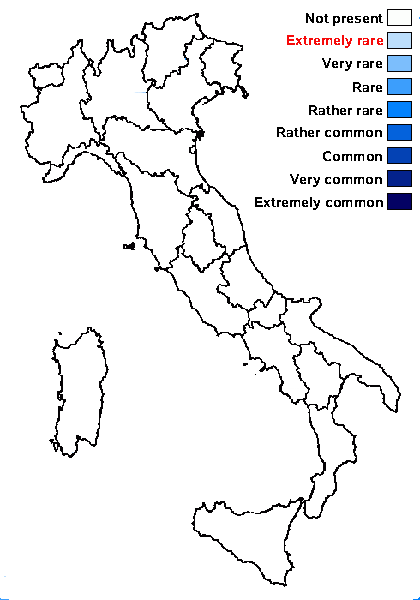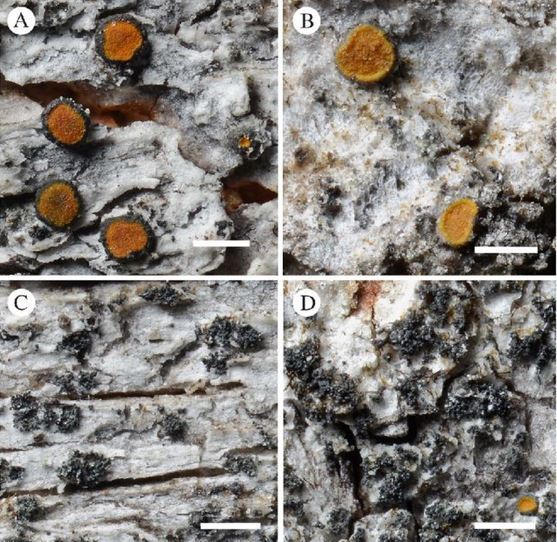Parvoplaca nigroblastidiata Arup, Halıcı & Vondrák
in Arup & al., Lichenologist, 47: 384, 2015.
Synonyms:
Distribution:
Description: Thallus crustose, endosubstratic, sometimes staining the bark grey, blastidiate, without a distinct prothallus, often forming wide patches. Blastidia dark grey to black, sometimes with a bluish tinge, (15-)20-30(-35) μm, with a paraplectenchymatous cortex, sometimes forming conblastidia, arising in scattered, orbicular, 0.1-0.5 mm wide, thin, flat, irregular spots, sometimes coalescing into 1 mm wide patches. Apothecia rather frequent, scattered, immersed at first but soon adnate to sessile, round to irregular, (zeorine-)lecanorine, 0.3-0.5(-0.8) mm across, with a slightly concave to slightly convex, yellow-orange (rarely darker) disc, a dark grey-black, raised, often blastidiate thalline margin, and sometimes a yellow parathecial ring. Thalline exciple 25-60(-75) μm wide, with a 2-35 μm thick, well-delimited paraplectenchymatous cortex; epithecium yellow-orange, granular, K+ red; hymenium colourless, (50-)65-80(-110) μm high; paraphyses simple or sparingly branched, 2-2.5 μm thick in lower part, the apical cells up to 3.5(-4.5) μm wide; hypothecium colourless or pale brown, 50-100 μm high. Asci 8-spored, clavate, functionally unitunicate, apically thickened with a broad internal beak, the inner part of apex and external cap I+ blue, Teloschistes-type. Ascospores 2-celled, polarilocular, hyaline, ellipsoid to broadly ellipsoid, (10-)11-15(-17.5) x (4-)5-8(-9) μm, the equatorial thickening (“septum”) (2.5-)3-5(-5.5) μm. Photobiont chlorococcoid. Spot test: thallus K-, C-, KC-, P- (but cortex K+ violet N+ red in sections); apothecial disc K+ red. Chemistry: thallus and thalline margin of apothecia with the Sedifolia-grey pigment; apothecia with parietin (major), fallacinal, emodin, teloschistin and parietinic acid (minor or traces), corresponding to chemosyndrome A of Søchting (1997). Note: a recently-described epiphytic species, to be looked for also in Italy.
Growth form: Crustose
Substrata: bark
Photobiont: green algae other than Trentepohlia
Reproductive strategy: mainly asexual, by soredia, or soredia-like structures (e.g. blastidia)
Commonnes-rarity: (info)
Alpine belt: absent
Subalpine belt: absent
Oromediterranean belt: absent
Montane belt: absent
Submediterranean belt: absent
Padanian area: absent
Humid submediterranean belt: extremely rare
Humid mediterranean belt: extremely rare
Dry mediterranean belt: absent

Predictive model

Ulf Arup - Source: Lichenologist, 47,6 , 2015 , pp. 379-385
A, typical apothecia with some blastidia on the thalline margin (Jonsson FU5959); B, morphotype common in Turkey where a proper margin is present (Nordin FU8788); C, typical soralia with dark blastidia (Jonsson FU5959); D, (holotype) well-developed soralia with one young apothecium. Scales = 0.5 mm.
Growth form: Crustose
Substrata: bark
Photobiont: green algae other than Trentepohlia
Reproductive strategy: mainly asexual, by soredia, or soredia-like structures (e.g. blastidia)
Commonnes-rarity: (info)
Alpine belt: absent
Subalpine belt: absent
Oromediterranean belt: absent
Montane belt: absent
Submediterranean belt: absent
Padanian area: absent
Humid submediterranean belt: extremely rare
Humid mediterranean belt: extremely rare
Dry mediterranean belt: absent

Predictive model

 Index Fungorum
Index Fungorum
 GBIF
GBIF

